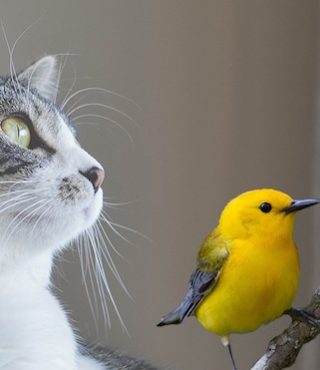What Kinds of Birds are Vulnerable to Cats?

While it’s difficult, perhaps impossible, to gather comprehensive and accurate scientific data on how many of which species of birds get killed by cats, we do know that certain birds’ nesting and feeding behaviours make them more vulnerable. Birds that nest and forage in trees are not as much at risk as those that nest or feed on the ground. Birds that live in wetlands and forests are less vulnerable, as cats tend to avoid those areas.
In an article in Avian Ecology, Environment Canada scientist Peter Blancher identifies 115 species that are vulnerable to cats. Forty of those 115 species are often present in urban or suburban landscapes, where the cat population is denser. 23 species at risk in Canada (COSEWIC 2012) are among the potentially vulnerable species.
Here’s a peak at just three of those bird species:
American Tree Sparrow: Plump and long-tailed, American Tree Sparrows are busy visitors in winter backyards and weedy, snow-covered fields across southern Canada and the northern United States. Hopping up at bent weeds or even beating their wings to dislodge seeds from grass heads, they scratch and peck the ground in small flocks, trading soft, musical twitters. Come snowmelt, these small rusty-capped and smooth-breasted sparrows begin their long migrations to breeding grounds in the tundra of the far North. Conservation status: Least concern. However, according to Christmas Bird Count data, American Tree Sparrows have declined by 2.2 percent annually between 1966 and 2005.
Barn Swallow: Characterized by its velvety blue posterior and long forked tail, the barn swallow is one of the most widespread species in the world, and can be found on every continent except for Antarctica and Australia. It is a rather small bird which is easily identified by its distinctive flight behaviour in which groups of at least a dozen individuals fly close to the ground in zig-zagging patterns. What may seem like random movements is, however, actually a method developed to efficiently forage for insects and feed without having to stop mid-flight. As their name implies, these birds commonly nest in various human structures, including on the underside of bridges and of course, in barns. The Canadian population has declined by 80% since 1970, and Barn Swallows are now classified as Threatened.
Killdeer: A shorebird you can see without going to the beach, Killdeer are graceful plovers common to lawns, golf courses, athletic fields, and parking lots. These tawny birds run across the ground in spurts, stopping with a jolt every so often to check their progress, or to see if they’ve startled up any insect prey. Their voice, a far-carrying, excited kill-deer, is a common sound even after dark, often given in flight as the bird circles overhead on slender wings. Conservation status: Least concern. However, according to the Breeding Bird Survey, Killdeer populations in Canada have declined by 3.2% annually between 1970 and 2012.
Click here to read Peter Blancher’s article in full.
Click here to download Blancher’s list of bird species that are vulnerable to cats.
Photo Credit: Rene McKibbin








